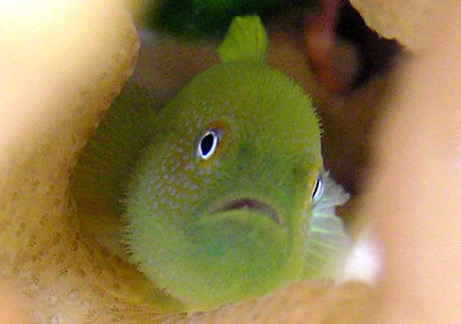
Some coral reef fish starve themselves to avoid getting into fights with their larger, dominant neighbors, researchers have found. Emerald coral gobies live in small groups in which social rank is strictly determined by body size. Within each group only the largest, dominant female mates with the one resident male.
Rather than competing for the top spot, subordinate female gobies often limit their own growth to remain non-threatening to higher-ranking fish.
Underlying this strategy of peaceful coexistence is fear of being kicked out and left to die, the researchers say.
Each goby group of up to 17 individuals occupies a single coral colony that provides food and shelter. (Related: “Young Fish Return to ‘Home Reefs’ to Settle Down” [May 4, 2007].)
When a subordinate goby approaches the size of a dominant, it risks being forcibly evicted from the social group. Predators quickly snatch up most females driven out of the colonies.
“We believe that eviction results in near certain death,” said Marian Wong of James Cook University in Townsville, Australia.
Wong’s team found that with such extreme penalties, low-ranking gobies voluntarily go on crash diets to maintain their own modest position in the social hierarchy.
“When [females] reach a size difference of approximately 5 percent relative to their immediate dominant, they suddenly cease feeding,” Wong said.
By regulating their size, Wong said, the fish minimize the risk of conflict and eviction.
“Evictions are uncommon in the wild,” Wong said. “It is more the threat of being punished that promotes stability, as opposed to the act of punishment itself.”
The research appeared earlier this year in the journal Proceedings of the Royal Society At Lizard Island on Australia’s Great Barrier Reef, the researchers measured the size of individually marked female gobies to determine their rank within their group.
Subsequent measurements six months later allowed the researchers to compare growth rates of dominant and subordinate females.
Subordinates that started out considerably smaller than the next-largest fish grew quickly at first. But growth slowed or ceased when the subordinate’s size approached 95 percent of the higher-ranking fish.
Laboratory experiments confirmed that at this size ratio, conflict between dominants and subordinates greatly increased in frequency. While subordinates occasionally prevailed, dominants were much more likely to drive away their challengers.
The field and lab results together showed that throughout the size hierarchy gobies regulated their food intake to avoid provoking fights they are unlikely to win.
In the short term, Wong said, this strategy benefits dominants, who don’t have to use force to prevent lower-ranking fish from breeding. Because of this, she said the behavior may be viewed as a form of cooperation.
But female gobies that avoid open conflict over rank may eventually advance to the top of the “breeding queue” by simply outliving their superiors.
“Lower-ranked group members do indeed move up in rank, and this usually occurs upon the natural death of one or more higher-ranked group members within the queue,” Wong said.
Social Contract?
Social systems in which dominant females hold a monopoly on reproduction are also found in some mammals, such as meerkats. In such animal societies, social harmony is maintained by a delicate balance of coercion and cooperation.
“Ostracism or eviction from the group is an enormously powerful threat to enforce compliance,” noted Michael Cant of England’s University of Cambridge.
In meerkat societies, subordinate females that become pregnant are often evicted by dominants. The gobies appear to take things a step further, with threat of eviction preventing surbordinates from moving even one step higher in rank.
Cant noted that the role of threat in structuring animal societies is inherently difficult to study.
“The idea that the threat of eviction leads to growth restraint in subordinates had been hypothesized before but not shown experimentally,” he said.
“More generally, this work raises the possibility that there may be hidden threats influencing individual behavior and group characteristics—threats which are invisible unless the social rules are broken,” he added.
Another Cambridge researcher, Rufus Johnstone, said the fact that gobies recognize and respond to such threats is particularly interesting.
“It might not sound so surprising, but it implies that they have their own simple form of social contract,” Johnstone said. “Even though eviction may be rare, the threat alone is enough to maintain a strict breeding queue.”



